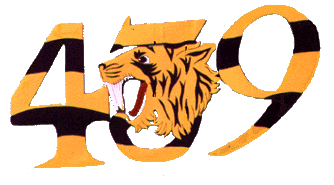|
History
of
 Squadron Squadron
  
Chapter
VI
Winter in the Netherlands
November 1944 January
1945
The squadron had by now been on operations for eight months and five of the old timers simultaneously reached the mile post that marked the end of the long trail that had started at Hurn in March l944. The two flight commanders, F/Ls J.E. Hogg and C.L. Burgess,
had 105 and 102 sorties respectively; F/Os B.P. Swingler had 101,
N.H. Rassenti 97 and P.N. Bernhart 96. Jimmy Hogg and Chuck Burgess both received the D.F.C. upon their departure from the squadron.
Burgess's citation read:
"This officer has taken part in a large number of operational missions and has led the squadron on a number of occasions with excellent results. While leading a section in close support of
the army in July 1944, this officer achieved a large measure of success; approximately 30 tanks were destroyed. On operations against enemy communications F/L Burgess, in spite of heavy
opposition, has destroyed much enemy transport. He has always pressed home his attacks with the utmost determination" .
|
Intentionally
left blank
|
Intentionally
left blank
|
For Jimmy Hogg the award stated:
"This officer, who is a flight commander, has participated in a large number of operational sorties and under his able leadership the squadron has attained many successes. On one occasion he led his section in an attack on a large rail
way bridge over the Rhine. Undeterred by intense anti aircraft fire
from the enemy's defences, he pressed home a determined attack and the bridge was destroyed. More recently F/L Hogg has led the squadron in attacks against enemy communications in Germany and Northern Holland, often in the face of heavy opposition."
The posting of these five O.T.E. pilots left F/O Ivan Smith as the only remaining member of the original group of 31, and he was rapidly approaching the end of his eventful tour. F/L J. Carr stepped up to command of "A" Flight in succession to Chuck Burgess, and F/L R.G. Crosby was posted in from No.438 to replace Jimmy Hogg in "B" Flight. Crosby, who naturally bore the nickname
"Bing", had seen much experience on Typhoons. Early in January 1944, while flying with No. 56 (R.A.F.) Squadron, he had been forced to bail out over northern France. Thanks to the help of members of the French underground he was able to evade capture until his journey could be arranged across France and Spain to Gibraltar. Early in May he returned to England and was soon back on operations. A mention in
dispatches paid tribute to his successful evasion.
|
|
Only one other replacement, P/O A.E. Derouin, was posted in from the Group Support Unit with the result that
No. 439 was somewhat under its usual strength until the end of the month when three more recruits boosted the total to 23
pilots.
(1) The newcomers were F/L
K.F. Sage and F/Os W. Kubicki and V.H.J. Le Gear.
Mention should also be made of two other additions to the squadron's strength. One day the newly acquired dog mascot "Typhie" began whining and howling around the office tent, but the unsuspecting orderly room staff could discover no explanation until two baby "Typhoons" appeared!
  
Copyright
©1998-2016 Michael T. Melnick. All rights reserved
the
unofficial homepage of  Tiger
Squadron Tiger
Squadron
.
.
|
|